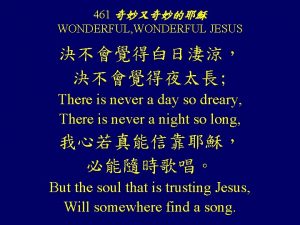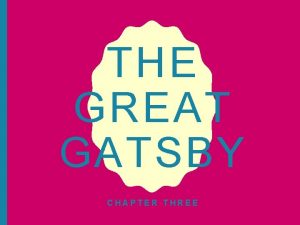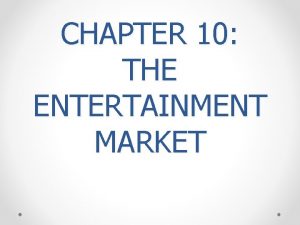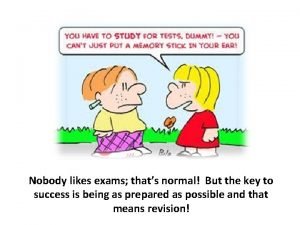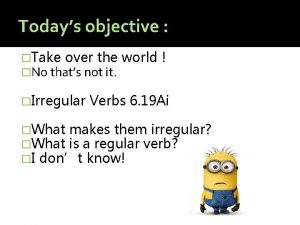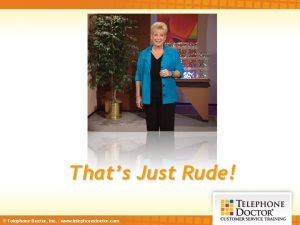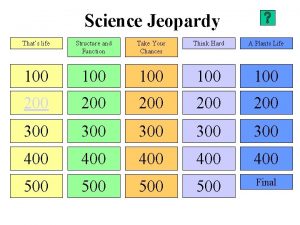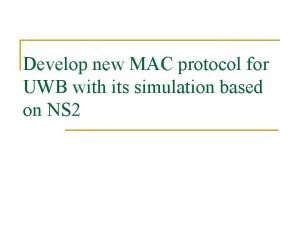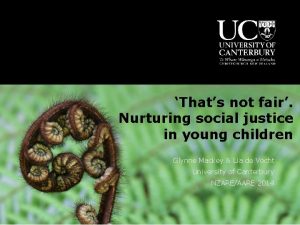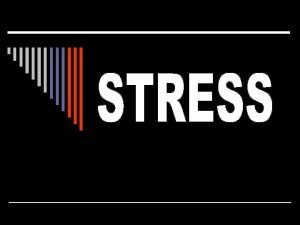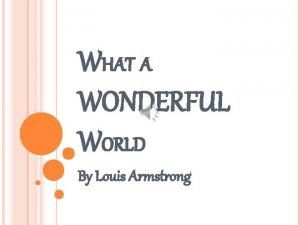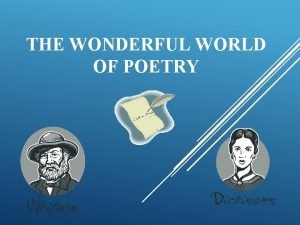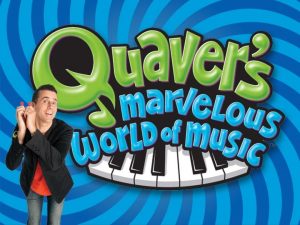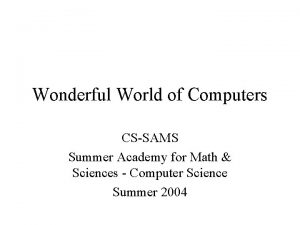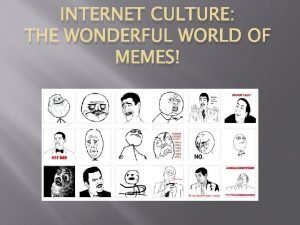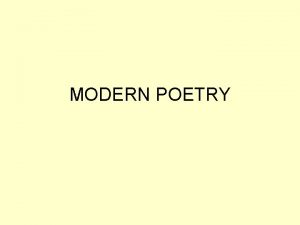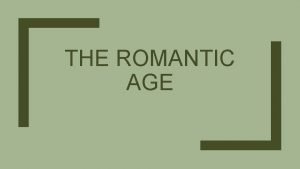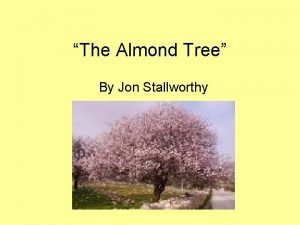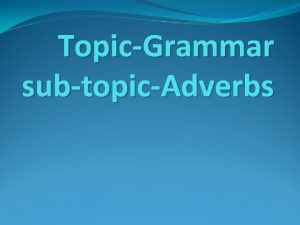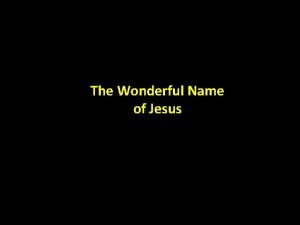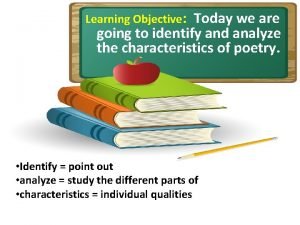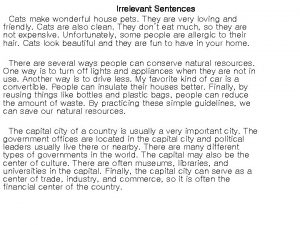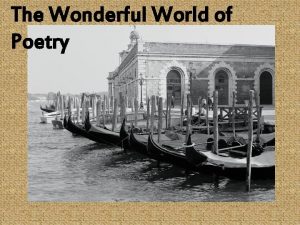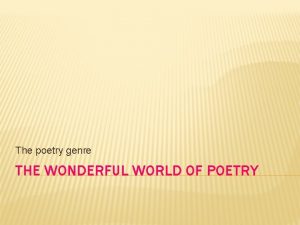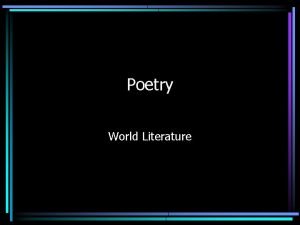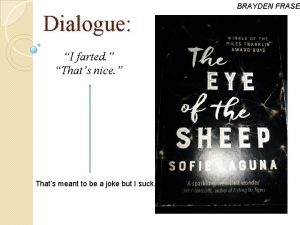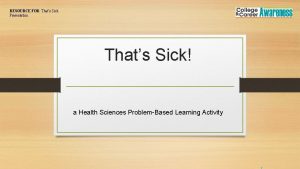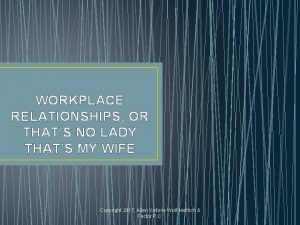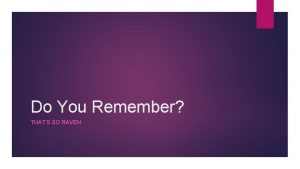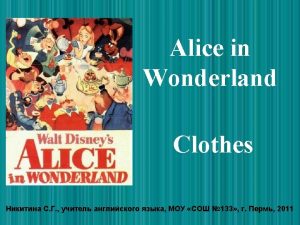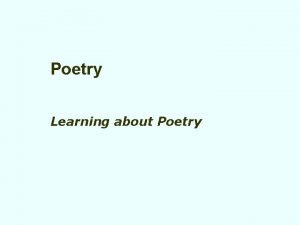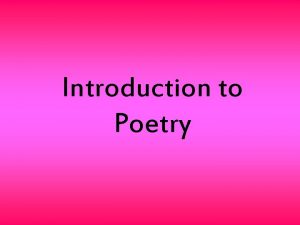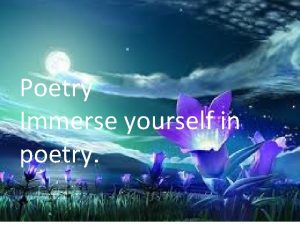Welcome to the Wonderful World of Poetry thats































- Slides: 31

Welcome to the Wonderful World of Poetry… (that’s an alliteration!) We don't read and write poetry because it's cute. We read and write poetry because we are members of the human race. And the human race is filled with passion. Medicine, law, business, engineering, these are noble pursuits and necessary to sustain life. But poetry, beauty, romance, love, these are what we stay alive for. ~Dead Poet's Society

What you will learn SWBAT recognize and describe the form and/or structure of poetry IOT analyze how form and/or structure contribute to meaning.

What is special about poetry? Poetry is a genre (type/form) of literature. –Poetry is written in a specific form lines and stanzas.

Defining Terms • Structure – the arrangement of and relationship between the parts or elements • Contribute – to be an important factor in; help cause • Meaning –what is expressed or indicated

POETRY FORM • FORM - the appearance of the words on the page • LINE - a group of words together on one line of the poem • STANZA - a group of lines arranged together A word is dead When it is said, Some say. I say it just Begins to live That day. Emily Dickinson

What contributes to a poem’s structure? • Rhyme (internal and end) Rhyme Scheme Rhyme scheme might connect certain ideas/images to each other. • Rhythm and meter • Stanzas • Punctuation—where the poet places a , and.

How does form contribute to meaning? • How does the form/structure of this poem contribute to the meaning? A word is dead When it is said, Some say. I say it just Begins to live That day. Emily Dickinson

Consider sound devices, figurative language and word choice in the poems we read as we look at examples of several types of poetry.

FREE VERSE POETRY • Free Verse=Free of rules • Free verse poetry is very conversational - sounds • Unlike metered poetry, like someone talking free verse poetry does with you. NOT have any repeating patterns of stressed and unstressed syllables. • Considered a more modern type of poetry. • Does NOT have rhyme.

Free Verse Fog The fog comes on little cat feet. It sits looking over harbor and city on silent haunches and then moves on. -Carl Sandburg

The Ballad The earliest forms of poetry were often passed down through music. A ballad is a poem that tells a story. Ballads are usually written in quatrains (stanzas with four lines). They are generally quite lengthy, with many stanzas.

LYRIC POETRY • Generally a short poem • Usually written in first person point of view • Expresses – an emotion – an idea or – describes a scene or person • Does not tell a story • Is often very musical/rhythmic

Lyric Poetry VI (If I Can Stop One Heart From Breaking) If I can stop one heart from breaking, I shall not live in vain; If I can ease one life the aching, Or cool one pain, Or help one fainting robin Unto his nest again, I shall not live in vain. Emily Dickinson

Sonnet A sonnet is a poem with fourteen lines written in a specific rhyme scheme. Usually expresses a single idea with a reversal or change in direction in the concluding lines There are two forms: Italian and English

Sonnet 116 Quatrain Couplet Let me not to the marriage of true minds a Admit impediments. Love is not love b Which alters when it alterations finds, a Or bends with the remover to remove. b Oh no! it is an ever-fixed mark c That looks on tempests and is never shaken. d It is the star to every wandering bark, c Whose worth’s unknown, although his height be taken. d Love’s not Time’s fool, those rosy lips and cheeks e Within his bending sickle’s compass come. f Love alters not with his brief hours and weeks, e But bears it out even to the edge of doom. f If this be error and upon me proved, g I never write, nor no man ever loved. g -William Shakespeare (setting up the problem) (beginning to answer the problem) (problem solved)

Ode • A poem that addresses one particular subject, usually to admire it Examples: • Ode to a Grecian Urn • Ode to My Socks • Ode on Spring • America

Ode to My Hips By Lucille Clifton these hips are big hips. they need space to move around in. they don't fit into little petty places. these hips are free hips. they don't like to be held back. these hips have never been enslaved, they go where they want to go they do what they want to do. these hips are mighty hips. these hips are magic hips. i have known them to put a spell on a man and spin him like a top

Stages to Reading Poetry • Stage 1: Paint Job Read • Stage 2: Pop the Hood Read • Stage 3: Mean Machine Read

Stage 1: Paint Job Read • Read it aloud once. • What is the title? What does it have to do with the poem? • Who is the speaker? How do I know? • What is the gist of the poem? What is the main idea of each stanza or section? • What is the overall feeling or mood? Does it change anywhere? • What is my first impression of theme (or statement or observation the poem is making about the world or the human condition)?

Stage 1: Paint Job Read- Try it! a line of a poem does not have to be a sentence a line of a poem can be a fragment of a sentence with or without punctuation With or without capital letters it can spread taking time itself out as it floats down the page.

Stage 2: Pop the Hood Read • Read it aloud again. • While reading, underline anything that “pulls” you. • What words stick out to me? How do they contribute to the mood? • What poetic tools does the author use? What figurative language can I identify? How does each technique contribute to meaning? • What is emphasized through structure? Why? • What is emphasized through repetition? Why is this repeated? • Are there any patterns? Rhyme? Rhythm? When are they broken? • How does sound create mood? Why?

Stage 2: Pop the Hood Read a line of a poem does not have to be a sentence a line of a poem can be a fragment of a sentence with or without punctuation With or without capital letters it can spread taking time itself out as it floats down the page.

Stage 3: Mean Machine Read • Read it aloud again. • What is the overall theme? • How do the sound, words, and shape of this poem work together to create meaning?

Stage 3: Mean Machine Read a line of a poem does not have to be a sentence a line of a poem can be a fragment of a sentence with or without punctuation With or without capital letters it can spread taking time itself out as it floats down the page.

Poetry Breakdown! • With a partner, choose a poem to analyze. • Glue your poem on the middle of your chart paper. • Read your poem in the 3 stages just modeled for you. Annotate your poem in a different color for each stage. Make it look PRETTY!!! • Tomorrow you will finish and present!

Thursday- Poetry Breakdown! How does form and structure contribute to meaning?

Form and Structure • What form does poetry take? • Identify 3 specific forms of poetry. • Define “structure. ”

3 Stages • • What are the 3 stages of poetry? What do you do in the 1 st stage? 2 nd stage? 3 rd stage?

Poetry Breakdown • Finish annotating your poem using the 3 stages we learned yesterday. • Write 2 paragraphs (one for stage 2, one for stage 3) explaining your annotations and findings. Make sure to cite evidence and analyze your evidence fully. • Be ready to present in 30 minutes.

Poetry Breakdown Presentations • Read your poem aloud to your audience. • Then read each stanza aloud analyze it using the 3 stages. • Explain your theme and how that theme was communicated in the poem. • Take questions from your audience.

So, how do I figure out what the poem means to me? Word choice is a key. . every word is significant Connotation: The way a word makes us feel. Denotation: The actual dictionary definition of the word. Words can give us different feelings when we hear them…some positive, some negative, and everything in between! See the example below The following words and phrases all refer to "a young person, " but their connotations may be quite different depending, in part, on the context in which they appear: youngster, child, kid, little one, small fry, brat, urchin, juvenile, minor. Some of these words tend to carry favorable connotations (little one), others unfavorable (brat), and still others fairly neutral connotations (child). Calling a young person a brat lets our readers know at once how we feel about the rotten kid.
 God's love is so wonderful
God's love is so wonderful Wonderful wonderful jesus
Wonderful wonderful jesus Here i go out to see again the sunshine fills my hair
Here i go out to see again the sunshine fills my hair Welcome back i hope you had a wonderful holiday
Welcome back i hope you had a wonderful holiday “i hope i never will. i hate careless people.”
“i hope i never will. i hate careless people.” I hate careless people thats why i like you
I hate careless people thats why i like you Thats entertainment dance competition
Thats entertainment dance competition Mind rhyming words
Mind rhyming words Thats normal
Thats normal Thats all im asking for
Thats all im asking for No thats not it
No thats not it Thats just rude
Thats just rude Gambar sel
Gambar sel Uwb protocol analyzers
Uwb protocol analyzers Thats not fair
Thats not fair Promotions o'cool
Promotions o'cool Dynamics of what a wonderful world
Dynamics of what a wonderful world Figurative language in what a wonderful world
Figurative language in what a wonderful world Quavers wonderful world of music
Quavers wonderful world of music The wonderful world of computers
The wonderful world of computers Marasmius haematocephala
Marasmius haematocephala Wonderful world meme
Wonderful world meme Wise men three clever are we
Wise men three clever are we Neoclassical poetry vs romantic poetry
Neoclassical poetry vs romantic poetry Experimentation in modern poetry
Experimentation in modern poetry What is a lyrical poem
What is a lyrical poem Augustan age characteristics
Augustan age characteristics Almond trees poem
Almond trees poem Wonderful adverb
Wonderful adverb The wonderful name of jesus
The wonderful name of jesus Spaghetti spaghetti you're wonderful stuff
Spaghetti spaghetti you're wonderful stuff Cats make wonderful house pets
Cats make wonderful house pets

